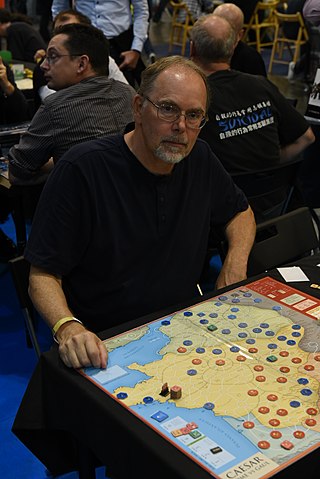
Strategy & Tactics (S&T) is a wargaming magazine now published by Decision Games, notable for publishing a complete new wargame in each issue.
Simulations Publications, Inc. (SPI) was an American publisher of board wargames and related magazines, particularly its flagship Strategy & Tactics, in the 1970s and early 1980s. It produced an enormous number of games and introduced innovative practices, changing the course of the wargaming hobby in its bid to take control of the hobby away from then-dominant Avalon Hill. SPI ran out of cash in early 1982 when TSR called in a loan secured by SPI's assets. TSR began selling SPI's inventory in 1982, but later acquired the company's trademarks and copyrights in 1983 and continued a form of the operation until 1987.

Game Designers' Workshop (GDW) was a wargame and role-playing game publisher from 1973 to 1996. Many of their games are now carried by other publishers.

The Charles S. Roberts Awards is an annual award for excellence in manual, tabletop games, with a focus on "conflict simulations", which includes simulations of non-military as well as military conflicts, as well as simulations of related historical topics. From its founding in 1975 through 2021, the award was almost exclusively focused on historical wargaming, changing to a broader "conflict simulations" in award year 2022.

The Wargamer was a magazine devoted to the hobby of board wargaming. Originally published as a British bimonthly magazine by UK Wargamers in 1977, it was subsequently published by World Wide Wargames, which then moved to the United States. The magazine ceased publication in 1990.

Richard Harvey Berg was a prolific American wargame designer. He was inducted into the Charles Roberts Awards Hall of Fame in 1987.

Tactics is a board wargame published in 1954 by Avalon Hill as the company's first product. Although primitive by modern standards, it and its sequel, Tactics II, signalled the birth of modern board wargaming for the commercial market. Tactics is generally credited as being the first commercially successful board wargame.

War in Europe is a grand strategic "monster" board wargame published by Simulations Publications Inc. (SPI) in 1976 that attempts to simulate the entirety of the European theatre of World War II from 1939 to 1945. One of the largest wargames ever produced, War in Europe features 4000 counters, four rulebooks, and nine maps that when placed together cover an area of 38.5 ft2. The game is nominally a three-player game, but each side can be represented by teams of players. SPI estimated the full game would take at least 180 hours.
World Wide Wargames, or 3W, was a wargame company founded in 1977 by Keith Poulter.

A board wargame is a wargame with a set playing surface or board, as opposed to being played on a computer or in a more free-form playing area as in miniatures games. The modern, commercial wargaming hobby developed in 1954 following the publication and commercial success of Tactics. The board wargaming hobby continues to enjoy a sizeable following, with a number of game publishers and gaming conventions dedicated to the hobby both in the English-speaking world and further afield.

NATO: Operational Combat in Europe in the 1970s is a board wargame published by Simulations Publications Inc. (SPI) in 1973 that simulates an invasion of Western Europe by the Warsaw Pact.

Mark Simonitch is an American wargame designer and graphic artist. His game designs include Hannibal: Rome vs. Carthage and Ardennes '44, and he has made maps for Wilderness War and Empire of the Sun among others. He has worked at Avalon Hill and GMT Games. He was inducted into the Charles Roberts Awards Hall of Fame in 2002.

Ted S. Raicer is a game designer who has worked on board games. He became a board wargamer at the age of 12 years and has published more than 10 games based on World War I. Raicer has won many awards in his gaming career.
Keith Poulter is a publisher and an editor who has worked on both magazines and wargames.

The Ironclads, subtitled "A Tactical Level Game of Naval Combat in the American Civil War 1861–1865", is a board wargame published by Yaquinto Publications in 1979 that simulates American Civil War naval combat.

JagdPanther is a game magazine that was published from 1973 to 1976.

EastFront, subtitled "The War in Russia: 1941–45", is a board wargame published by Columbia Games in 1991 that is simulation of the conflict between Germany and the Soviet Union during World War II.

The Game of France, 1940: German Blitzkrieg in the West, originally titled "The Battle for France, 1940", is a board wargame originally published by Simulations Publications Inc. (SPI) in 1971 that was subsequently re-issued by Avalon Hill in 1972. Both editions simulate the World War II Battle of France in 1940, when the German blitzkrieg offensive overwhelmed French and British defenses in northern France.

Proud Monster: The Barbarossa Campaign is a board wargame published by GTX in 1994 that simulates Operation Barbarossa, Germany's surprise attack on the Soviet Union during World War II.














